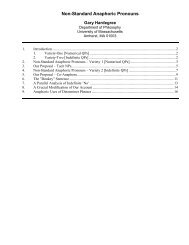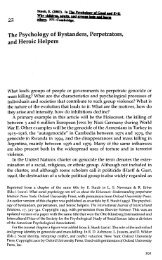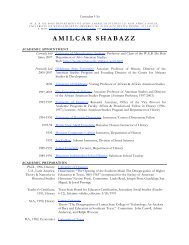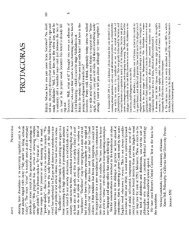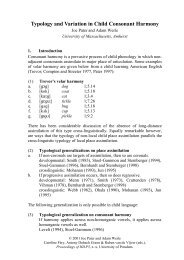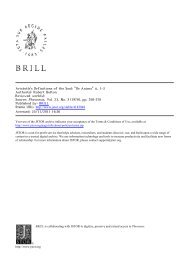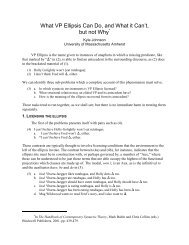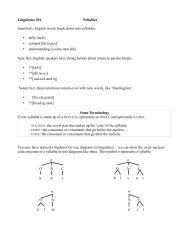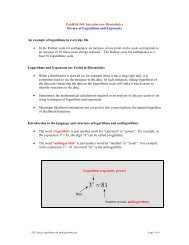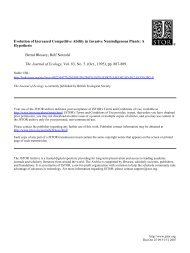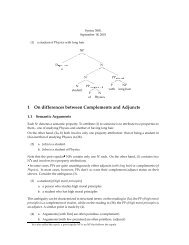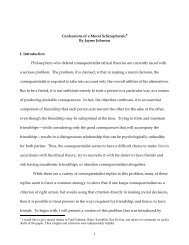Lexically conditioned variation in Harmonic Grammar
Lexically conditioned variation in Harmonic Grammar
Lexically conditioned variation in Harmonic Grammar
Create successful ePaper yourself
Turn your PDF publications into a flip-book with our unique Google optimized e-Paper software.
OCP-5, Toulouse-Le Mirail, 01-26-08<br />
<strong>Lexically</strong> <strong>conditioned</strong> <strong>variation</strong> <strong>in</strong><br />
<strong>Harmonic</strong> <strong>Grammar</strong><br />
Joe Pater, University of Massachusetts, Amherst<br />
with the collaboration of<br />
Paul Boersma, University of Amsterdam<br />
Andries Coetzee, University of Michigan<br />
Isabelle Rac<strong>in</strong>e, Université de Genève
<strong>Lexically</strong> <strong>conditioned</strong> <strong>variation</strong>:<br />
(1) A variable process whose probability of application is<br />
<strong>conditioned</strong> by the lexicon<br />
Three extremely well-studied variable phonological<br />
processes that display lexical condition<strong>in</strong>g:<br />
(2) English vowel reduction (Fidelholtz 1975 et seq.)<br />
embrace > emporium<br />
English t/d-deletion (Labov et al. 1968 et seq.)<br />
jus(t) > bus(t)<br />
French ‘schwa’ deletion (Dell 1973 et seq.)<br />
s(e)ma<strong>in</strong>e > s(e)mestre
<strong>Lexically</strong> <strong>conditioned</strong> <strong>variation</strong> is a particular focus of usagebased<br />
and exemplar-based approaches to phonology:<br />
(3) English:<br />
Bybee (2001), Pierrehumbert (2001), Phillips (2006)<br />
French:<br />
Sobbotta (2006), Eychenne and Pustka (2007)<br />
Key observation (Dell 1973, Fidelholtz 1975)<br />
(4) Word frequency correlates positively with frequency of<br />
application of these variable processes
Argument for usage-based phonology:<br />
(5) Frequency of use ~ frequency of application<br />
correlation not captured by other models of phonology<br />
A def<strong>in</strong>ition of the doma<strong>in</strong> of phonological theory:<br />
(6) Native speaker knowledge of the sound patterns of<br />
language<br />
(7) The acquisition of that knowledge<br />
It rema<strong>in</strong>s unclear whether the correlation <strong>in</strong> (5) is <strong>in</strong> (6), and<br />
therefore whether phonology should account for it (that is,<br />
the correlation could well be a product of use, as per Bybee)
However, s<strong>in</strong>ce speakers do at least know that words differ<br />
<strong>in</strong> their probability of application of variable processes, and<br />
s<strong>in</strong>ce they learn this probability, an adequate theory of<br />
phonology must provide a way of represent<strong>in</strong>g lexically<br />
<strong>conditioned</strong> <strong>variation</strong>, and its associated learn<strong>in</strong>g theory<br />
should provide an account of its acquisition.<br />
Current phonological theory provides the needed <strong>in</strong>gredients<br />
(HG = <strong>Harmonic</strong> <strong>Grammar</strong>, Smolensky and Legendre 2006)<br />
(8) Theory of <strong>variation</strong> (Boersma 1997 et seq.)<br />
Stochastic OT/Noisy HG<br />
Theory of lexical condition<strong>in</strong>g (Pater 2000 et seq.)<br />
<strong>Lexically</strong> <strong>in</strong>dexed constra<strong>in</strong>ts<br />
Theory of learn<strong>in</strong>g (Boersma 1997, Boersma and Pater 2008)<br />
Gradual learn<strong>in</strong>g algorithm for OT/HG
Coetzee and Pater (2008) illustrate this approach to lexically<br />
<strong>conditioned</strong> <strong>variation</strong> with English t/d-deletion<br />
Today:<br />
§1. Introduction to the theories of grammar (HG), <strong>variation</strong><br />
(noisy HG) and learn<strong>in</strong>g (HG-GLA) I’ll be assum<strong>in</strong>g, with<br />
French e-deletion as the illustrative example<br />
§2. Presentation of data on lexical condition<strong>in</strong>g of French edeletion,<br />
especially from Rac<strong>in</strong>e’s (2007) study of native<br />
speaker judgments<br />
§3. Further analysis and learn<strong>in</strong>g simulations<br />
§4. Other HG approaches to lexical condition<strong>in</strong>g of edeletion<br />
§5. Broader implications
1. HG, <strong>variation</strong>, exceptionality, and learn<strong>in</strong>g<br />
In HG (Legendre, Miyata and Smolensky 1990, Smolensky<br />
and Legendre 2006) well-formedness, or Harmony (H) of<br />
representation (R), is the sum of its weighted constra<strong>in</strong>t<br />
violations/scores (constra<strong>in</strong>t score vector C and weights W)<br />
(9) H(R) = 〈C, W〉<br />
Pr<strong>in</strong>ce and Smolensky (1993/2004:236) note that HG Harmony<br />
can be used to choose the optimum <strong>in</strong> a candidate set:<br />
(10)<br />
CON-1 CON-2<br />
Input-1<br />
2 1<br />
Output-11 -1 -2<br />
Output-12 -1 -1
Applied to e-deletion (where [ә] is the vowel represented by orthographic<br />
e, which varies from dialect to dialect)<br />
(11)<br />
*[ә] MAX<br />
sәmɛn 2 1<br />
sәmɛn -1 -2<br />
smɛn -1 -1<br />
Constra<strong>in</strong>t def<strong>in</strong>itions:<br />
(12) *[ә]<br />
Assign a score of -1 for each vowel [ә]<br />
MAX<br />
Assign a score of -1 for each vowel <strong>in</strong> the <strong>in</strong>put that<br />
lacks an output correspondent
Boersma’s (1997 et seq.) theory of <strong>variation</strong>:<br />
(13) Noisy evaluation<br />
Each time the grammar is used to evaluate a<br />
candidate set, add a Gaussian random variable Nk to<br />
each constra<strong>in</strong>t weight wk<br />
Applied to e-deletion (post-noise values <strong>in</strong> parentheses)<br />
(14)<br />
sәmɛn<br />
*[ә]<br />
1<br />
(1.1)<br />
MAX<br />
1<br />
(0.9)<br />
sәmɛn<br />
*[ә]<br />
1<br />
(0.9)<br />
MAX<br />
1<br />
(1.1)<br />
sәmɛn –1 –1.1 sәmɛn –1 –0.9<br />
smɛn –1 –0.9 smɛn –1 –1.1<br />
(see Andreassen’s 2004 similar ‘float<strong>in</strong>g constra<strong>in</strong>t’ analysis of French schwa)
The distribution of [ә] is subject to categorical restrictions<br />
(Mart<strong>in</strong>et 1969, Dell 1973; cf. Walker 1993):<br />
(15) a. Word-<strong>in</strong>itial deletion never occurs after a<br />
tautomorphemic cluster (*gr(e)nouille, *Br(e)ton)<br />
b. [ә] occurs only after consonants, and is<br />
productively deleted after vowels (vous joueriez vs.<br />
vous parleriez from jouer and parler)<br />
A constra<strong>in</strong>t satisfied by the presence of [ә] (assum<strong>in</strong>g e-deletion<br />
results <strong>in</strong> an empty-headed syllable, as <strong>in</strong> Rialland 1986, though cf. Steriade<br />
2000 – the constra<strong>in</strong>t may be better def<strong>in</strong>ed <strong>in</strong> articulatory or perceptual terms):<br />
(16) LICENSE-C<br />
Assign a violation mark to a consonant <strong>in</strong> syllable<br />
without a vocalic nucleus
In HG, the difference between the C_ and CC_<br />
environments can be analyzed as the difference between<br />
one or two violations of LICENSE-C<br />
(See Pater, Bhatt and Potts 2007 for critical assessment of extant arguments for<br />
strict dom<strong>in</strong>ation, and discussion of outstand<strong>in</strong>g issues)<br />
(17)<br />
sәmɛn<br />
*[ә]<br />
1.5<br />
LIC-C<br />
1<br />
brәtɔ̃<br />
*[ә]<br />
1.5<br />
LIC-C<br />
1<br />
sәmɛn –1 –1.5 brәtɔ̃ –1 –1.5<br />
smɛn –1 –1 brtɔ̃ –2 –2<br />
And the restriction of [ә] to post-consonantal position can be<br />
understood as a ‘gang effect’ between LICENSE-C and MAX,<br />
as <strong>in</strong> the follow<strong>in</strong>g Richness of the Base tableau<br />
(see Dell 1973 for a rule-based analysis of post-V deletion, <strong>in</strong>clud<strong>in</strong>g a Richness<br />
of the Base approach to that phonotactic gap, and an MSC aga<strong>in</strong>st <strong>in</strong>itial [ә])
(18)<br />
(19)<br />
*[ә] LIC-C MAX<br />
CәCVC 1.5 1 1<br />
CәCVC –1 –1.5<br />
CCVC –1 –1 –2<br />
*[ә] LIC-C MAX<br />
CVәCVC 1.5 1 1<br />
CVәCVC –1 –1.5<br />
CVCVC –1 –1<br />
This analysis is <strong>in</strong>termediate between the analyses of<br />
‘schwa’ as epenthetic (Mart<strong>in</strong>et 1969, Côté 2006) and underly<strong>in</strong>g:<br />
(20) Underly<strong>in</strong>g ‘schwa’ can surface only when it serves to<br />
satisfy a markedness pressure (e.g. LICENSE-C)
To account for exceptions to e-deletion, I use a lexically<br />
specific version of MAX<br />
(lexically specific faithfulness <strong>in</strong>troduced to OT <strong>in</strong> Pater 2000 to account for<br />
lexical condition<strong>in</strong>g of English vowel reduction; see also esp. Ito and Mester 1995<br />
et seq. for applications to lexical condition<strong>in</strong>g <strong>in</strong> Japanese)<br />
(21) MAX-L<br />
Assign a violation mark for every <strong>in</strong>put segment that<br />
belongs to lexical item L and that lacks an output<br />
correspondent<br />
A word like belon (a type of oyster), whose first vowel<br />
apparently never undergoes deletion (Angoujard 2006, Eychenne<br />
2007), is dist<strong>in</strong>guished from sema<strong>in</strong>e <strong>in</strong> terms of the relative<br />
rank<strong>in</strong>g of the MAX-L constra<strong>in</strong>t <strong>in</strong>dexed to each of them.
How does an analyst f<strong>in</strong>d a weight<strong>in</strong>g for the constra<strong>in</strong>ts that<br />
generates the patterns <strong>in</strong> a given language? How does a<br />
learner f<strong>in</strong>d such a weight<strong>in</strong>g?<br />
For analysis of categorical patterns <strong>in</strong> HG, and comparison<br />
of typology <strong>in</strong> HG and standard OT:<br />
(22) HaLP (Potts, Becker, Bhatt, Pater 2007)<br />
OT-Help (Becker, Pater, Potts 2007)<br />
For patterns of <strong>variation</strong>, and simulation of human learn<strong>in</strong>g:<br />
(see Jäger to appear for an earlier similar proposal)<br />
(23) HG-GLA <strong>in</strong> Praat (Boersma and Ween<strong>in</strong>k 2007)
The HG-GLA is a very simple learn<strong>in</strong>g algorithm, which<br />
adapts a mach<strong>in</strong>e learn<strong>in</strong>g procedure (perceptron, stochastic<br />
gradient ascent) to the learn<strong>in</strong>g of HG grammars, and<br />
closely resembles Boersma’s (1997 et seq.) OT-GLA<br />
Unlike the OT-GLA for stochastic OT, it is guaranteed to<br />
converge on correct weight<strong>in</strong>gs for categorical data:<br />
(24) HG-GLA convergence<br />
Fischer 2005, Boersma and Pater 2008<br />
OT-GLA/stochastic OT non-convergence<br />
Pater 2008
I provided the HG-GLA with the follow<strong>in</strong>g distribution of data:<br />
(25) sema<strong>in</strong>eL1 50% deletion<br />
belonL2 0% deletion<br />
bretonL3 0% deletion<br />
Initial constra<strong>in</strong>t weights:<br />
(see Jesney and Tessier 2007 on high Mark and low Faith <strong>in</strong> HG learn<strong>in</strong>g)<br />
(26) LICENSE-C, *[ә] 50<br />
MAX, MAX-L1, MAX-L2, MAX-L3 0<br />
Sett<strong>in</strong>gs were Praat’s defaults for these parameters:<br />
(27) Noise SD = 2.0<br />
Plasticity = 1.0 (decreased by a factor of 0.1 after<br />
each of 4 sets of 100,000 learn<strong>in</strong>g data)
The grammar model was run <strong>in</strong> L<strong>in</strong>ear OT mode (Keller 2006),<br />
under which it <strong>in</strong>terprets all sub-zero weights as zero<br />
(28) LICENSE-C 50.3<br />
*[ә] 49.7<br />
MAX-belon 17.0<br />
MAX-breton 0.0<br />
MAX –0.3<br />
MAX-sema<strong>in</strong>e –17.3<br />
Probability of e-deletion with grammar <strong>in</strong> (28), noise 2.0<br />
(29) a. sema<strong>in</strong>e 50% belon 0% breton 0%<br />
b. әCVC 100% CVәCVC 100%
3. <strong>Lexically</strong> <strong>conditioned</strong> e-deletion: data<br />
The simplified data <strong>in</strong> the previous section could be handled<br />
by any standard theory of generative phonology (e.g. Dell 1973)<br />
(30) sema<strong>in</strong>e subject to an optional rule of e-deletion<br />
belon marked as an exception to the rule<br />
breton does not meet conditions of the rule<br />
joueriez subject to obligatory post-V e-deletion<br />
*әCVC due to a Morpheme Structure Constra<strong>in</strong>t<br />
Dell (1973) provides an example of the type of lexical<br />
condition<strong>in</strong>g that cannot easily be handled by the theory he<br />
was work<strong>in</strong>g with, but which falls out from the one <strong>in</strong> §2.
In general, schwa deletion is blocked by a preced<strong>in</strong>g<br />
consonant (judgments from a native speaker <strong>in</strong> Nantes):<br />
(31) la s’ma<strong>in</strong>e ✓ une s’ma<strong>in</strong>e ??<br />
Dell writes his rule “VCE1” to apply only after vowels.<br />
However, he notes that (p. 207 <strong>in</strong> 1980 English translation):<br />
(32) Contrary to what we said above, <strong>in</strong> very rapid speech<br />
the schwa of a small number of words beg<strong>in</strong>n<strong>in</strong>g with<br />
#C __ can be dropped even if the preced<strong>in</strong>g word<br />
ends <strong>in</strong> a consonant: quelle sema<strong>in</strong>e is sometimes<br />
pronounced [kɛlsmɛn]...The other words that have<br />
this property <strong>in</strong> our speech are je, semelle, cerise,<br />
chemise, fenêtre and petit...there are other words<br />
which always behave accord<strong>in</strong>g to VCE1: semestre,<br />
ser<strong>in</strong>gue, chenille (glosses and transcriptions omitted)
The generalization:<br />
(33) The probability of schwa deletion is greater for words<br />
like sema<strong>in</strong>e than for words like semestre<br />
Further evidence of f<strong>in</strong>er dist<strong>in</strong>ctions than optional<br />
application vs. non-application:<br />
(34) a. Dictionaries f<strong>in</strong>d the two-way categorization<br />
<strong>in</strong>adequate (Walker 1996)<br />
b. Corpus-based studies note that some words show<br />
greater frequency of deletion than others (e.g. Hansen<br />
1994, Eychenne 2007, Eychenne and Pustka 2007)<br />
c. Rac<strong>in</strong>e and Grosjean (2002) provide data from a<br />
production study show<strong>in</strong>g a wide range of deletion<br />
frequencies across words
Dell (1973) notes that exceptions to schwa deletion tend to<br />
be rarely used or literary words (as well as proper names)<br />
He also claims to have systematically looked for<br />
phonological generalizations, and came up empty-handed<br />
(see also Walker 1996)<br />
Is it “just” usage frequency that determ<strong>in</strong>es deletability of<br />
schwa?
No.<br />
(35) Rac<strong>in</strong>e and Grosjean (2002) f<strong>in</strong>d a correlation<br />
between deletion and frequency rat<strong>in</strong>gs, but note that<br />
the correlation is not perfect.<br />
Accord<strong>in</strong>g to Fougeron, Goldman and Frauenfelder (2003):<br />
(36) Overall the results do not support our hypothesis:<br />
lexical frequency and competition do not appear to<br />
<strong>in</strong>fluence strongly whether liaison and elision are<br />
realised or not.<br />
(they also cite Adda-Decker et al. 1999 as hav<strong>in</strong>g reached the same conclusion)<br />
Therefore, not only do speakers need to learn whether a<br />
word has a “stable” or “unstable” e, but they need to learn its<br />
degree of stability, or profil de ma<strong>in</strong>tien (Walter 1977)
Rac<strong>in</strong>e’s (2007, <strong>in</strong> prep.) judgment study provides<br />
particularly conv<strong>in</strong>c<strong>in</strong>g evidence of speakers’ knowledge of<br />
<strong>in</strong>dividual words’ profil de ma<strong>in</strong>tien<br />
Method:<br />
12 native-speakers from Nantes, France (and 12 from Neuchâtel,<br />
Switzerland)<br />
All 2189 nouns conta<strong>in</strong><strong>in</strong>g schwa <strong>in</strong> BRULEX database (10<br />
elim<strong>in</strong>ated from analysis for be<strong>in</strong>g judged as [œ]/[ø])<br />
Presented orthographically with preced<strong>in</strong>g la/le<br />
The list was presented twice, with an <strong>in</strong>terval of several<br />
days; once all words were rated with e present, and once<br />
judged with it absent<br />
Rated on a scale of 1 (<strong>in</strong>frequent) to 7 (very frequent); data<br />
here are the means over the 12 subjects for each word
n=30 n=338
elon –5.4 semestre –4.6 sema<strong>in</strong>e 0.0
4. Analysis of probabilistic lexical condition<strong>in</strong>g<br />
Constra<strong>in</strong>t for e-deletion with preced<strong>in</strong>g consonant-f<strong>in</strong>al<br />
word:<br />
(35) *C.C.<br />
An unlicensed consonant must be preceded by a<br />
vowel<br />
Probability of deletion <strong>in</strong> learn<strong>in</strong>g data:<br />
(36) la sema<strong>in</strong>eL1 50% quelle sema<strong>in</strong>eL1 10%<br />
le semestreL2 10% quel semestreL2 0%<br />
le bretonL3 0% quel bretonL3 0%<br />
la belonL4 0% quelle belonL4 0%<br />
The markedness constra<strong>in</strong>ts aga<strong>in</strong> started out at 50, and the<br />
five faithfulness constra<strong>in</strong>ts (MAX, MAXL1...4) at zero
The constra<strong>in</strong>t weights found by the learner:<br />
(37) *[ә] 50.3<br />
LICENSE-C 49.7<br />
MAX-belon 15.0<br />
*C.C. 4.9<br />
MAX-semestre 4.8<br />
MAX-breton 0.0<br />
MAX –0.3<br />
MAX-sema<strong>in</strong>e –20.1<br />
Deletion rates:<br />
(38) la sema<strong>in</strong>e 52% quelle sema<strong>in</strong>e 10%<br />
le semestre 11% quel semestre 1%<br />
le breton 0% quel breton 0%<br />
la belon 0% quelle belon 0%<br />
әCVC 100% CVәCVC 100%
4. Alternative accounts <strong>in</strong> HG<br />
4.1 <strong>Lexically</strong> scaled weights (≈ connectionist lexicon)<br />
The numerically valued constra<strong>in</strong>ts of HG allow for views of<br />
lexical representation that diverge much further from<br />
“standard” generative phonology than lexically specific<br />
constra<strong>in</strong>ts<br />
Coetzee and Pater (2008) sketch one such alternative: that<br />
<strong>in</strong>dividual lexical items (or segments) bear numerical <strong>in</strong>dices<br />
that rescale the basic weight of faithfulness constra<strong>in</strong>ts (see<br />
also Goldrick 2008)<br />
For the word sema<strong>in</strong>e, the value of the faithfulness constant<br />
would be relatively low, thus lead<strong>in</strong>g to variable deletion
(39)<br />
*[ә] LIC-C MAX<br />
/sәmɛn/ 1 2.0 1.0 1*1=1<br />
[sәmɛn] –1 –2<br />
[smɛn] –1 –1 –2<br />
And for belon, the value of the faithfulness constant would<br />
be relatively high, thus lead<strong>in</strong>g to consistent retention<br />
(40)<br />
/bәlɔ̃/2<br />
*[ә]<br />
2.0<br />
LIC-C<br />
1.0<br />
MAX<br />
1*2=2<br />
[bәlɔ̃] –1 –2<br />
[blɔ̃] –1 –1 –3<br />
Lexical constants are more restrictive than lexically specific<br />
constra<strong>in</strong>ts, and faithfulness constra<strong>in</strong>t scal<strong>in</strong>g can be<br />
extended to register/style differences (Coetzee and Pater 2008; see<br />
van Oostendorp 1998 on register-based rerank<strong>in</strong>g of faithfulness)
4.2 Probabilistic allomophy (≈ exemplarist lexicon)<br />
In OT, “allomorphy” is used to describe a case when the<br />
phonology chooses between two lexically supplied forms of<br />
a morpheme (e.g. Kager, Mascaró, Tranel).<br />
If the lexicon provides <strong>in</strong> addition a default probability<br />
distribution over the allomorphs, then this could <strong>in</strong>teract with<br />
the contextual probabilities provided by the grammar to yield<br />
the observed condition<strong>in</strong>g by lexicon and context<br />
One way of formaliz<strong>in</strong>g this, similar <strong>in</strong> spirit to lexically<br />
specific constra<strong>in</strong>ts, is with a set of “Use-/X/” constra<strong>in</strong>ts<br />
(Kager 1996, Boersma 1999, Apoussidou 2006)
5. Broader consequences of lexically <strong>conditioned</strong><br />
<strong>variation</strong><br />
<strong>Lexically</strong> specific constra<strong>in</strong>ts, and the related approaches <strong>in</strong><br />
HG discussed <strong>in</strong> §4, are highly <strong>in</strong>teractive theories of the<br />
lexicon-grammar relationship<br />
This high degree of <strong>in</strong>teraction seems to be required to<br />
account for the f<strong>in</strong>e-gra<strong>in</strong>ed consequences of the lexicon on<br />
probability of e-deletion<br />
Coetzee and Pater (2008) po<strong>in</strong>t out that lexically <strong>conditioned</strong><br />
<strong>variation</strong> is problematic for some widespread assumptions<br />
about the relationship between the lexicon and the<br />
phonological grammar
The hard question: what type of process is e-deletion?<br />
(41) Lexicon → Early Phonology → Late Phonology<br />
→ Phonetic Implementation<br />
As Walker (1996) po<strong>in</strong>ts out, e-deletion has contradictory<br />
properties under the view that processes at each of these<br />
levels have a set of fixed characteristics (a view most closely<br />
associated with classical Lexical Phonology; e.g. Kiparsky 1985)<br />
(42) i. Has exceptions (Lex/EP)<br />
ii. Sensitive to morphology (Lex/EP) (Dell 1973)<br />
iii. Variable (LP/PI)<br />
iv. Non-structure preserv<strong>in</strong>g, and may even lead to<br />
between category outcomes (LP/PI) (Fougeron and<br />
Steriade 1997, Barnes and Kavitskaya 2003; cf. Côté and Morrison<br />
2007)
The f<strong>in</strong>e-gra<strong>in</strong>ed lexical condition<strong>in</strong>g of rate of <strong>variation</strong> <strong>in</strong> edeletion<br />
(and the English processes mentioned <strong>in</strong> 2) seems<br />
to put the f<strong>in</strong>al nail <strong>in</strong> the coff<strong>in</strong> of the idea that processes at<br />
each of the levels <strong>in</strong> (41) have non-overlapp<strong>in</strong>g<br />
characteristics (see already Kiparsky 1993 on <strong>variation</strong> <strong>in</strong> OT)<br />
The fact that this variable process is sensitive to morphology<br />
and the lexicon places it firmly with<strong>in</strong> the doma<strong>in</strong> of<br />
phonology, and makes it hard to imag<strong>in</strong>e how one could<br />
ma<strong>in</strong>ta<strong>in</strong> a “categorical vs. probabilistic” dist<strong>in</strong>ction for<br />
dist<strong>in</strong>guish<strong>in</strong>g phonology from phonetics
References<br />
Andreasson, Helene. 2004. Une contra<strong>in</strong>te de fidélité flottante pour le traitement<br />
du schwa et de la liaison dans le canton de Vaud. Proceed<strong>in</strong>gs of PFC 3.<br />
Angoujard, Jean-Pierre. 2006. Phonologie déclarative. CNRS Editions, Paris.<br />
Barnes, Jonathan and Darya Kavitskaya. 2003. Phonetic analogy and schwa<br />
deletion <strong>in</strong> French. In Julie Larsen and Mary Paster, eds. Proceed<strong>in</strong>gs of the<br />
Twenty-Eighth Annual Meet<strong>in</strong>g of the Berkeley L<strong>in</strong>guistics Society. Berkeley:<br />
Berkeley L<strong>in</strong>guistics Society. p. 39-50.<br />
Becker, Michael, Joe Pater and Christopher Potts. 2007. OT-Help 1.1. Software<br />
package.University of Massachusetts, Amherst.<br />
[http://web.l<strong>in</strong>guist.umass.edu/~OTHelp/].<br />
Boersma, Paul. 1997. How we learn <strong>variation</strong>, optionality, and probability.<br />
Proceed<strong>in</strong>gs of the Institute of Phonetic Sciences of the University of<br />
Amsterdam 21. 43-58. [Available on Rutgers Optimality Archive, ROA-221.]<br />
Boersma, Paul. 1998. Functional Phonology: Formaliz<strong>in</strong>g the Interaction<br />
Between Articulatory and Perceptual Drives. The Hague: Holland Academic<br />
Graphics. [Doctoral dissertation, University of Amsterdam.]<br />
Boersma, Paul and Joe Pater. 2008. Convergence properties of a gradual<br />
learner <strong>in</strong> <strong>Harmonic</strong> <strong>Grammar</strong>. Ms., University of Amsterdam and University o<br />
Massachusetts, Amherst.
Boersma, Paul and David Ween<strong>in</strong>k. 2007. Praat: Do<strong>in</strong>g Phonetics by Computer.<br />
(Version 5.0.01). [Computer program]. Retrieved December 18, 2007, from<br />
http://www.praat.org/<br />
Bybee, Joan. 2001. Phonology and Language Use. Cambridge: Cambridge<br />
University Press.<br />
Coetzee, Andries and Joe Pater. 2008. The Place of Variation <strong>in</strong> Phonological<br />
Theory. To appear <strong>in</strong> John Goldsmith, Jason Riggle and Alan Yu, eds.,<br />
Handbook of Phonological Theory (2 nd ed.)<br />
Côté, Marie-Hélène and Geoffrey Stewart Morrison. 2007. The nature of the<br />
schwa-zero alternation <strong>in</strong> French clitics: experimental and non-experimental<br />
evidence. Journal of French language studies 17: 159-186.<br />
Dell, François.1973. Les règles et les sons. Orléans: Imprimerie Nouvelle. [trans.<br />
1980 by Cather<strong>in</strong>e Cullen as Generative phonology and French phonology.<br />
Cambridge University Press.]<br />
Eychenne, Julien. 2006. Aspects de la phonologie du schwa dans le français<br />
contempora<strong>in</strong> optimalité, visibilité prosodique, gradience. PhD. dissertation,<br />
Université de Toulouse-Le Mirail.<br />
Eychenne, Julien and Elissa Pustka. 2007. The Initial Position <strong>in</strong> Southern<br />
French: Elision, Suppletion, Emergence. . Proceed<strong>in</strong>gs of JEL’2007, ed. Jean-<br />
Pierre Angoujard and Olivier Crouzet, Université de Nantes. 199-204.
Fidelholtz, J. 1975. Word frequency and vowel reduction <strong>in</strong> English. In CLS,<br />
11:200-213.<br />
Fougeron, Cécile and Steriade, Donca. (1997). Does the deletion of French<br />
schwa lead to the neutralization of lexical dist<strong>in</strong>ctions? Proceed<strong>in</strong>gs of the<br />
Eurospeech conference, Rhodes. 943–946.<br />
Goldrick, Matt. 2008. A harmonic grammar account of lexically-<strong>conditioned</strong><br />
phonetic <strong>variation</strong>. Paper presented at L<strong>in</strong>guistic Society of America Annual<br />
Meet<strong>in</strong>g. Chicago.<br />
Hansen, A. 1994. Etude du E caduc—stabilisation en cours et <strong>variation</strong>s<br />
lexicales. Journal of French Language Studies 4: 25-54.<br />
Kiparsky, Paul. 1982. Lexical phonology and morphology. In In-Seok Yang, ed.<br />
L<strong>in</strong>guistics <strong>in</strong> the Morn<strong>in</strong>g Calm. Seoul: Hansh<strong>in</strong>. p. 1-91.<br />
Kiparsky, Paul. 1985. Some consequences of Lexical Phonology. Phonology<br />
Yearbook, 2:85-138.<br />
Kiparsky, Paul. 1993. An OT perspective on phonological <strong>variation</strong>. Handout from<br />
Rutgers Optimality Workshop 1993, also presented at NWAV 1994, Stanford<br />
University. Available at http://www.stanford.edu/~kiparsky/<br />
Papers/nwave94.pdf<br />
Labov, William, P. Cohen, C. Rob<strong>in</strong>s and J. Lewis. 1968. A study of the nonstandard<br />
English of Negro and Puerto Rican Speakers <strong>in</strong> New York City.
Cooperative Research Report 3288. Vols I and II. Philadelphia: U.S. Regional<br />
Survey (L<strong>in</strong>guistics Laboratory, U. of Pa.)<br />
Legendre, Gérald<strong>in</strong>e, Yoshiro Miyata and Paul Smolensky. 1990. Can<br />
connectionism contribute to syntax? <strong>Harmonic</strong> <strong>Grammar</strong>, with an application.<br />
In M. Ziolkowski, M. Noske and K. Deaton, eds. Proceed<strong>in</strong>gs of the 26th<br />
Regional Meet<strong>in</strong>g of the Chicago L<strong>in</strong>guistic Society. Chicago: Chicago<br />
L<strong>in</strong>guistic Society. p. 237-252.<br />
Mart<strong>in</strong>et, A. 1969. Le français sans fard. Paris: Presses Universitaires de France.<br />
Oostendorp, Marc van. 1997. Style Levels <strong>in</strong> Conflict Resolution. In Frans<br />
H<strong>in</strong>skens, Roeland van Hout and Leo Wetzels, eds. Variation, Change and<br />
Phonological Theory. Amsterdam: John Benjam<strong>in</strong>s. p. 207-229.<br />
Pater, Joe. 2000. Non-uniformity <strong>in</strong> English secondary stress: the role of ranked<br />
and lexically specific constra<strong>in</strong>ts. Phonology, 17:237-274. [Published version<br />
of 1995 ms. available on Rutgers Optimality Archive, ROA-107.]<br />
Pater, Joe. 2008. Gradual learn<strong>in</strong>g and convergence. L<strong>in</strong>guistic Inquiry 39.<br />
[Available at http://people.umass.edu/pater/pater-gradual-converge.pdf.]<br />
Pater, Joe, Rajesh Bhatt and Christopher Potts. 2007. L<strong>in</strong>guistic Optimization.<br />
Manuscript. Amherst, MA: University of Massachusetts Amherst. [Available at<br />
http://people.umass.edu/pater/pater-bhatt-potts-hg07.pdf.]<br />
Phillips, Betty S. 2006. Word Frequency and Lexical Diffusion. New York:<br />
Palgrave Macmillan.
Pierrehumbert, Janet B. 2001. Exemplar dynamics: Word frequency, lenition,<br />
and contrast. In Joan Bybee and Paul Hopper, eds. Frequency Effects and the<br />
Emergence of Lexical Structure. Amsterdam: John Benjam<strong>in</strong>s. p. 137-157.<br />
Rac<strong>in</strong>e, Isabelle. 2007. Effacement du schwa dans des mots lexicaux:<br />
constitution d'une base de données et analyse comparative. Proceed<strong>in</strong>gs of<br />
JEL’2007, ed. Jean-Pierre Angoujard and Olivier Crouzet, Université de<br />
Nantes. 125-130<br />
Rac<strong>in</strong>e, Isabelle and François Grosjean. 2002. La production du E caduc<br />
facultatif est-elle prévisible? Un début de réponse. Journal of French<br />
Language Studies, 12: 307-326.<br />
Smolensky, Paul and Gérald<strong>in</strong>e Legendre. 2006. The <strong>Harmonic</strong> M<strong>in</strong>d: From<br />
Neural Computation to Optimality-Theoretic <strong>Grammar</strong>. Cambridge, MA: MIT<br />
Press/Bradford Books.<br />
Sobotta, Elissa. 2006. Phonologie et migration – aveyronnais et guadeloupéens<br />
à paris. Thèse de doctorat, Universités Paris X - Nanterre et LMU de Munich.<br />
(= Pustka).<br />
Walker, Douglas C. 1993. Schwa and /œ/ <strong>in</strong> French. Canadian Journal of<br />
L<strong>in</strong>guistics, 38(1):43–64.<br />
Walker, Douglas C. 1996. The new stability of of unstable -e <strong>in</strong> French. French<br />
Language Studies, 6. 211-229.<br />
Walter, H. 1977. La phonologie du français. Paris: PUF.



